What is an International Phone Number and How to Get One?

Statistics show that, on average, people around the world make around 6.2 billion international calls each year. The world is your oyster, and that also applies to businesses. Years ago, smaller companies focused exclusively on local markets. But nowadays, having an international presence isn’t a corporate privilege anymore.
Thanks to internet telephony apps (forecasted to grow from $1.4 billion in market value in 2020 to $1.8 billion by 2028), there’s unlimited access to cheap global calling. Their virtual international numbers enable even the smallest start-ups to build an international presence.
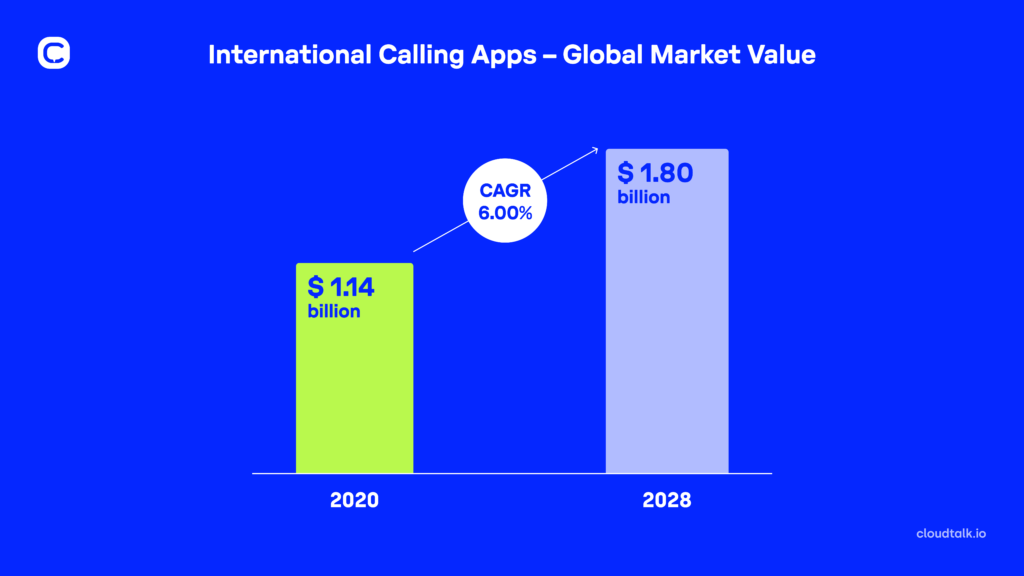
In this blog, we will take a closer look at international numbers. Let’s explore what they are, how they work, and why every ambitious business definitely needs one.
So, keep reading and kickstart your journey towards a global expansion!
Key takeaways:
- International phone numbers let you establish a local presence in multiple countries without physical offices. They help you to establish trust and provide accessibility for customers worldwide.
- Utilizing VoIP international numbers significantly reduces costs for both you and your customers. They offer local call rates for international calls and eliminate the need for expensive traditional phone lines.
- Virtual international numbers provide the flexibility to seamlessly add or remove numbers as your business size fluctuates. You can easily get one with CloudTalk.
What Is an International Phone Number?
So, what is the meaning of an international phone number?
It’s basically a standard phone number but with a country code prefix. This prefix is used to identify each country or region and allows you to call globally from anywhere in the world.
We will discuss international number formats in more depth later on, but for now, here are a few examples:
- USA: +1
- UK: +44
- Spain: +34
- Germany: +49
- Australia: +61
- Japan: +81
- Brazil: +55
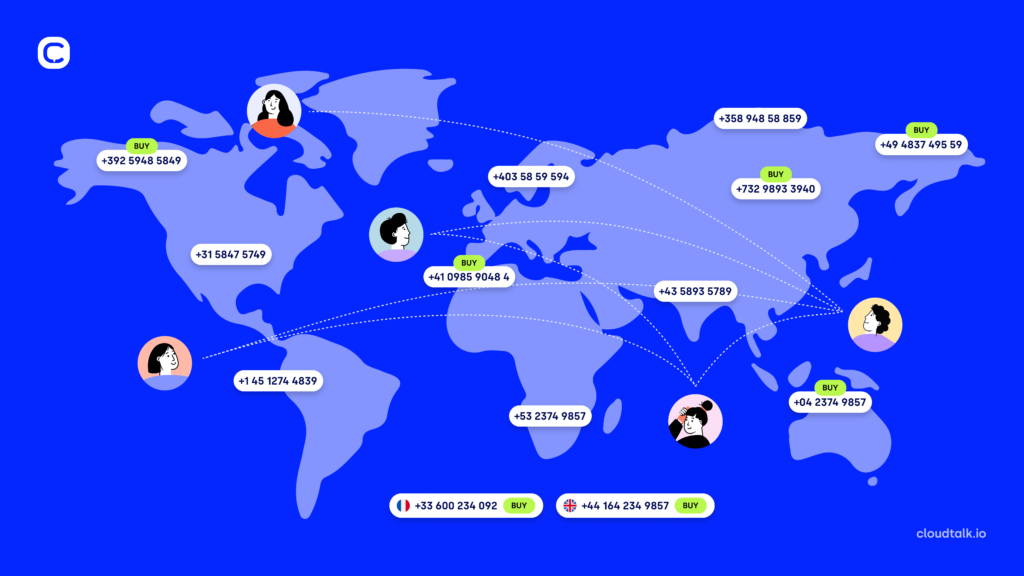
You can call from a standard mobile phone number using the international number format, but that may cost you.
For example, AT&T’s basic mobile calling rates from the US to Canada cost $1.55 per minute. From the US to Mexico, it grows to $3.65 per minute. And if you want to contact someone in China, you’ll pay a staggering $5 per minute.
VoIP (Voice over Internet Protocol) international numbers allow you to eliminate these costly fees. You can call as if you were in the same country as the recipient. And, of course, customers can call you the same way.
These numbers look just like any other phone number with a country code prefix, but they are virtual – i.e., associated with a VoIP calling software. To use them, you have to pay a monthly subscription and a small one-time fee for purchasing a specific international number.
Now, let’s take a closer look at the anatomy of an international number.
Types of International Numbers
There are 2 types of international numbers you should get familiar with in order to fully understand how calling abroad works.
These include:
#1 Local Phone Numbers
Local numbers, also called geographic numbers, have a digit structure linked to a specific geographical area. Therefore, you can zoom in even further and target major regions or cities, such as London and Madrid, with a phone number identical to their local ones.
Let’s use Madrid as an example. The Spanish country code is +34, and the local area code for Madrid is 91.
The phone number for calling Madrid would therefore look like this: +34 (91) 123 4567
If you want to call London, you’d dial: +44 (020) 123-4567.
It works the same way for US states. They not only have different local area codes for each state but also for different regions inside of the states. Major metropolises, such as New York, even have different area codes for city districts.
Here are a few examples:
- Montana: +1 (406) 123 4567
- Main: +1 (207) 123 4567
- Delaware: +1 (302) 123 4567
- New York City (all): +1 (917) 123 4567
New York City (borough of Manhattan):
- +1 (212) 123 4567
- +1 (646) 123 4567
- +1 (332) 123 4567
#2 Toll-free Phone Number
The toll-free number is a type of phone number customers can dial without being charged for the call. Instead, the cost is paid by the number’s owner. Therefore, a call receiver. The cost can also be split between the caller and receiver, depending on the type of toll-free number.
Those where the receiver pays the full price are called green toll-free numbers. The latter are known as blue toll-free numbers.
You can recognize a toll-free number by its unconventional format. It includes specific 3-digit prefixes starting with 8, the most common being 800.
The main point of toll-free numbers is to make your business contact memorable. They also create a bridge between you and your customers. By giving them an option to call you without worrying about expensive long-distance charges, you evoke a feeling of trust.
Here are a few examples of a toll-free international number format:
- UK: +44 (8XX) 123 456
- US: +1 (8XX) 123 456
- Spain: +34 (8XX) 123 456
- Germany: +49 (8XX) 123 456
We have the highest international number coverage on the market!
How Do International Phone Numbers Work?
You already know that VoIP international numbers add a country-specific prefix in front of a standard phone number. With VoIP providers like CloudTalk, you can get as many of them as you want.
But how do all those international numbers connect to the same calling software?
It’s simple. When a customer calls one of the international numbers, the call is automatically transferred to your primary one but still acts like it was made locally. It’s a way of “fooling” the system into believing you are actually in the same country as the caller.
Here’s a practical example:
Let’s say your business is located in Australia. A customer calls you from the US. Normally, an international call like this would cost a fortune. But luckily, you have a US international number with the “+1” prefix.
The customer dials it, and the call is automatically redirected to your main call center number. Their rates will equal a phone call they’d make within the US, so they won’t break the bank over contacting you.
To help you imagine the significance of international numbers, here’s how much the customer would pay to call Australia from the US if you didn’t have one:
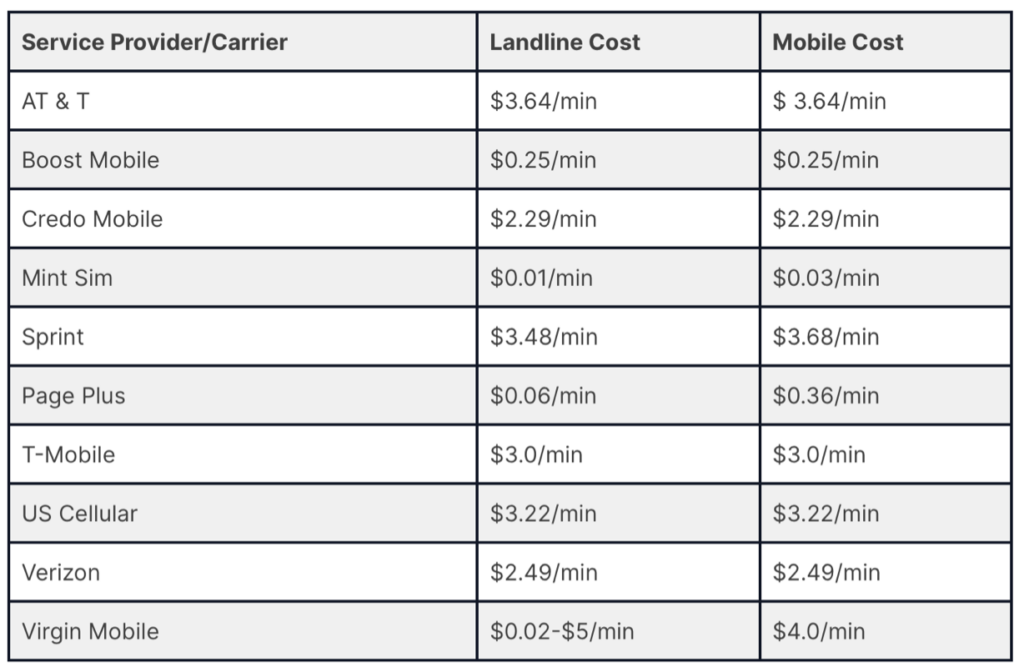
Now, let’s take a look at how the VoIP part works.
We said that international VoIP numbers are unrecognizable from standard phone numbers. So what’s the difference?
International VoIP numbers work over the Internet. This means that instead of being associated with a physical address, they are linked to an IP address. They are hosted in a virtual phone system, usually cloud-based.
How to Call an International Number?
Calling a virtual international number is as straightforward as calling any other number on your landline or mobile phone.
We already peeked into what certain components of international numbers look like.
Now, let’s put all that knowledge into practice.
We prepared a step-by-step guide on how to explain the international dialing process, from the first to the last digit. It’s based on a practical international dialing use case:
So, let’s say that you are about to call a business partner in Spain.
First, you’ll have to write the Spanish area code (+34).
Don’t know what your area code is? Here’s a handy source.
As you can see, the country prefix always needs to have a “+” before it, but it can also be replaced with “00” or “011” for Canada and the US.
Thus, so far, we have this:
+34 / 0034 / 01134
Moving on, let’s assume that your call recipient is in Barcelona. We will add a local area prefix after the main country code: +34 (93)
Alternatively, you may be making a call to a toll-free number. In that case, our number would so far look like this: +43 (8XX).
Finally, there’s the last and simplest step ahead. You need to add your business partner’s personal number.
Spanish phone numbers have 9 digits, so the final number should look like this:
- + 34 (93) 1234-56789
- +43 (8XX) 1234-5678
Fun fact:
Do you know which 3 countries make the most international calls? It’s the US, Germany and the UK.
We offer international numbers for all three of them for as little as $6 per piece.
Benefits of International Numbers
We might have already hinted at some, but international numbers have such ground-breaking benefits that you may want to stick around!
Here’s a deep dive into the most impactful ones:
#1 Save Costs for You and Customers
Perhaps the strongest benefit is that neither you nor your customers have to worry about expensive international calling fees. As we mentioned, callers can contact you as if they were calling a local number in their country and vice versa.
And we are not talking about saving cents here. A 60-minute call to India, for example, can cost as much as $300.
Therefore, virtual international numbers make your business more accessible. People will feel more confident to call you, knowing they won’t spend a fortune. You can build an image of a trustworthy, fair company and elevate your customer loyalty. But more on that in a minute.
Main business advantage for: Customer Support (inbound calling)
What did Glovo achieved with CloudTalk?
- 82% Increase in the volume of calls
- 24% Decrease in missed calls

#2 Grow Revenue With a Trustworthy Global Presence
Did you ever get a phone call from a foreign number and refused to take it? If so, it was likely because you either thought it would cost you a fortune(we solved that one above) or were afraid that it was a scam call.
People simply tend not to trust phone calls from abroad. That’s why international numbers give you the unique opportunity to be local anywhere without actually being present there.
And here we circulate back to the loyalty aspect.
From a customer support standpoint, trusting your phone number empowers the customer base to contact you. That goes hand in hand with better customer experience, leading to your own network of loyal brand ambassadors.
But mainly, you will significantly boost sales pickup rates, because people aren’t hesitant to answer the familiar phone number. It means more customers, higher conversion rates, and better revenue flow.
Main business advantage for: Sales (outbound calling)
What did PlanRadar achieved with CloudTalk?
- 20% Increase in agent efficiency
- 70% Increase in call handling efficiency

#3 Add and Remove Numbers Flexibly
When it comes to regular phone numbers, there’s usually a limit on how many numbers you can have. Maybe you don’t want to spend too much money on buying additional hardware equipment. Or you just don’t have time for tons of paperwork.
With virtual international phone numbers, there is no hardware to buy or paperwork to fill out. You’ll have all the numbers incorporated in a single calling software, and you can add or remove them as you please. Your VoIP provider will do all the heavy lifting for you.
Main business advantage for: Company-wide
#4 Keep Your Data Safe
Cost saving, business success, flexible growth. Those are things that any business leader thinks of first. And it makes sense. But there’s one aspect connected to calling people that people tend to overlook, and that’s security.
A data breach can ruin your business, especially if you are dealing with sensitive information. According to Forbes, a data breach costs an average of $4.45 million!
Or even worse, it may get you into serious legal trouble.
VoIP international number providers are encrypted, making sure no 3rd party can intrude on your phone line and listen to your conversations. There are also regular security updates and protocols in place, protecting your customers’ data.
So, when choosing a calling software provider, keep the security in mind!
Main business advantage for: Company-wide
#5 BONUS: Boost Productivity With VoIP Features
Since virtual international numbers come as a part of VoIP calling software, they come with so much more than free, convenient calling. You can significantly boost your productivity, which you’ll now definitely need, with the higher volume of inbound calls and broader sales outreach.
With software like CloudTalk, you get 70+ advanced calling, automation, performance, and compliance features, as well as advanced AI tools. For example, you can automate your outbound calling with smart dialers, track overall performance to improve strategies, boost agent performance by monitoring their calls, follow customer sentiment to foster effective communication, and much more.
Main business advantage for: Company-wide
How Much Does an International Number Cost?
There’s no straightforward answer because the cost of international numbers depends on many factors. But to give you an idea, we will present you with the 3 main ones.
How much you’ll pay depends on:
#1 Which Provider You Chose
Which provider you select has a great impact on the price of international calling.
The first factor here is whether you want a standard number via providers like AT&T or a virtual one via VoIP software. Overall, if you have any calling expenses, VoIP calls have lower rates compared to traditional phone calls. In fact, VoIP fees can be as low as 2 cents per minute.
Furthermore, the price of obtaining international numbers also depends on which specific provider you choose. VoIP software pricing plans may vary significantly, from as little as $10 per user/month to as much as $200 per user/month.
So, you have to choose which software best fits your needs and budget and which of their plans works best for you. These plans also vary in price.
For example, CloudTalk offers 4 plans, ranging from $25 to $50. You’ll also get one phone number for free.
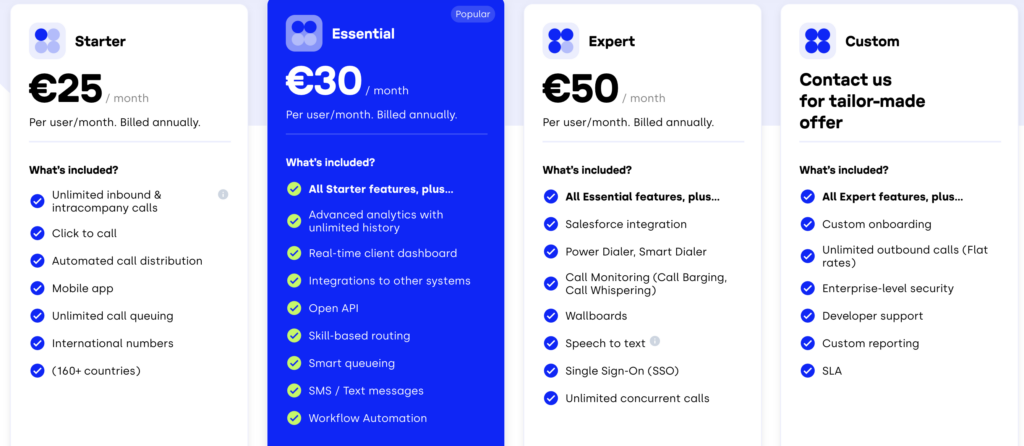
So, regarding choosing the provider, the cost depends on:
- What type of provider you want
- Which specific one you decide for
- Which of their plan you want to go with
#2 How Many Numbers Do You Need and From Where
When obtaining a virtual international phone number via a VoIP provider, you pay a one-time purchase fee for each number you choose. Prices vary from provider to provider and country to country. The final cost, therefore, depends on how many international numbers you need and which ones you are interested in.
However, VoIP international numbers are really affordable. Usually, more mainstream countries like Germany, Spain, or the UK are cheaper than less frequently demanded ones. For example, Monte Negro or Morocco.
Choose your numbers from our pricing list.
How to Set Up International Numbers With CloudTalk
Of course, you are free to choose to get your international numbers through any provider you want. But we hope that at this point, you are at least considering doing so via CloudTalk.
In case you do, here’s a walkthrough of how to obtain a virtual international number with us:
#1 Order Your International Number
From the CloudTalk Dashboard, you’ll navigate to the “Numbers” tab.
Then, you’ll click “Get a number”.
– On our Legacy Dashboard, there is “Buy New Number” instead. Don’t worry – you won’t be automatically charged if you just want to exchange a number.
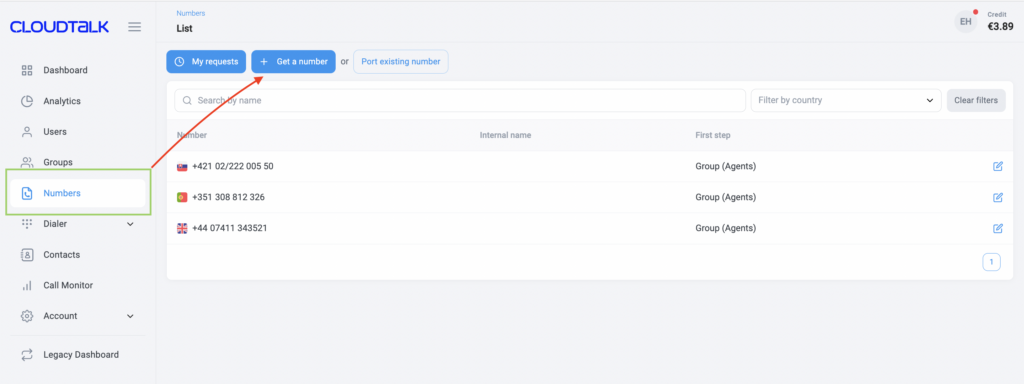
Then, you’ll select a country and specify the type of number you need.
In the bottom section “Additional documents (ID, business license, etc.)”, you will see the requirements per number and you’ll be able to upload them into the form.
If the section is blank, it means that there are no requirements.
In case you’d be using our Legacy Dashboard:
- If you are exchanging an existing number for a new one, you should mention this in a “Want to add something?” box.
The order form does not have a ‘requirement section’, but you can check all our number requirements by country and number type.
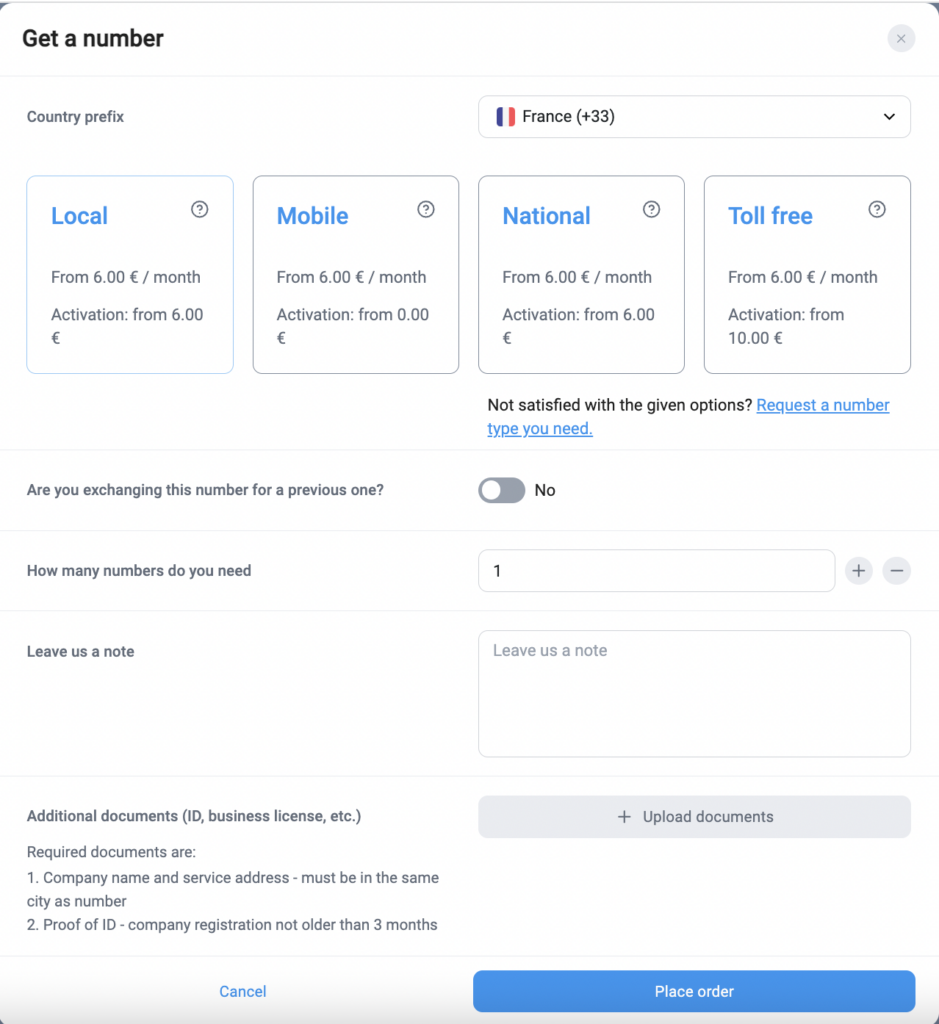
Next, after sending your request, you will see an order confirmation banner in the top corner. You will also receive a confirmation to your account email address.
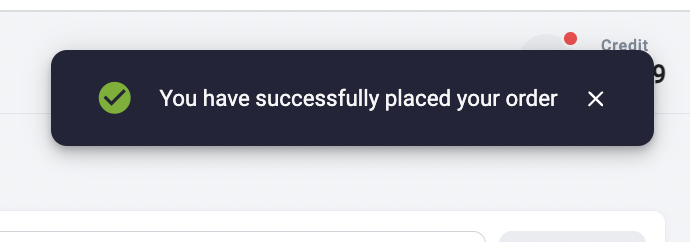
#2 We Will Review Your Request
The numbering team either adds the number or, if we need any additional documents or information from you, we will follow up in the confirmation email.
#3 We Will Add the Number to Your Account
Our team will include billing for the number and send a final confirmation email.
Tip: You can see the status of your ongoing requests in the main numbers section under “My Requests”.
Here’s what different status stages mean:
- New: we have received your request, but an agent has not processed it yet. We typically respond within 8-24 hours.
- Waiting for information: we have reviewed your request but need more information or additional documents. If you see this status, you should check your CloudTalk email.
- Processing: our team has everything they need for the request and is in the process of activating the number with our operator.
- Completed: the number has been added to your CloudTalk account. Our agent will clarify which specific number was added.
- Canceled: the request was canceled by your team.
- Expired: if a request stays in the “Waiting for information” stage for 2+ business days without a response from your side, we may close your request and mark it as expired.
See the full guide here.
Embrace Affordable Global Growth
Global expansion isn’t a big-players’ privilege anymore. Thanks to international phone numbers, even the smallest businesses can afford to build a worldwide presence worth an enterprise. What’s more, you’ll improve CX, close more deals, and grow revenue.
That all while saving costs for both you and your customers.
With a VoIP calling provider, such as CloudTalk, obtaining an international number is straightforward and efficient.
So, leave all the hassle on us and focus on the true purpose of getting one – growing beyond borders.
Start calling abroad now!
FAQs
How much does an international call cost?
The cost of an international call depends on the method you use. Traditional international calls using local SIM cards can be quite expensive, often costing several dollars per minute. However, using VoIP (Voice over Internet Protocol) services with virtual international numbers can significantly reduce these costs. For example, VoIP call rates can be as low as 2 cents per minute.
How to format international phone numbers?
International phone numbers start with a country code, followed by the local area code and the individual phone number. The format is as follows: + [Country Code] [Area Code] [Local Number]. For example, a number in Spain would be formatted as “+34 (91) 123 456789”, where +34 is the country code for Spain, 91 is the area code for Madrid, and “123 456789” is the local number.
How to call an international number?
To call an international number, start by dialing the international access code (e.g., “+” or 00 or 011 for the US and Canada), followed by the country code, the area code (if applicable), and the local phone number. For example, to call a number in Barcelona, Spain from the US, you would dial “011 34 (93) 123 456789” or “+34 (93) 123 456789”.
How to identify an international phone number?
You can identify an international phone number by its country code prefix, which appears at the beginning of the number. This prefix typically starts with a “+” sign followed by one to three digits that specify the country. For example, +1 indicates the USA, +33 indicates France, and +49 indicates Germany.
Is +1 the same as 011?
No, +1 and 011 are not the same, but they serve related purposes: +1 is the country code for the United States and Canada, used in the international number format. 011 is the international access code used in North America to dial out of the country. When calling from the US, you would dial 011 before the country code and number, whereas “+” can replace the international access code when using a mobile phone.
What does +44 mean in phone numbers?
+44 is the country code for the United Kingdom. It indicates that the phone number following this code is based in the UK. When dialing a UK number from abroad, you would start with +44 followed by the local number, omitting the initial zero of the local area code.
What is an international standard phone number?
An international standard phone number adheres to the E.164 format, which ensures global compatibility. This format includes a “+” followed by the country code, area code (if applicable), and the local subscriber number. For example, a standard international phone number format for a London number would be “+44 (20) 1234 5678”.
























